27 November, 2003
Setting Up Our Lab and Preparing to Process
Now that we’ve returned from our first trip to the Dry Valleys, it is time
to start processing the samples we collected.
Before we can start working with our samples, we needed to gather science
equipment, organize our lab, and prepare the media upon which the yeast
and bacteria will grow. Helping us accomplish this task are the final
members of the team, Scott Craig and Barb Schulz. Scott and Barb left
exactly a week after us and arrived while we were in the Dry Valleys. It
is nice to finally have the entire “Yeasty Boyz” team together.
Rusty and I started our day with a trip to the Crary Lab stock room to
gather the needed materials and lab equipment. An hour or two later we
returned with several carts containing balances, centrifuges, pH meters,
conductivity meters, shaker baths, tube rockers, incubator baths, and many
other needed supplies and misc. equipment. While we were gathering
equipment, Barb, Regina, and Laurie set up the lab by unpacking boxes,
putting away materials, sterilizing work areas, and organizing the lab.
Since microbes are found all over (on countertops, on us, etc.) we have to
be concerned about possible contamination. One way to ensure that the
“critters” that grow on our plates are indeed organisms we collected from
Antarctic soils is to sterilize our instruments with an autoclave. An
autoclave acts somewhat like a pressure cooker in that the items are
heated under extreme pressure and temperature. After 20-30 min in the
autoclave, any critters that might have been on the item would have been
killed, thus making it sterile. Since a lot of our equipment needed to be
sterilized, Barb and I spent much of the day autoclaving bottles of water
and misc. instruments and items that will come in contact with our samples.
Since we are studying living organisms, we must provide a proper food
source and climate in order for them to grow. Bacteria and yeast are grown
in plastic Petri dishes, or plates, that contain a gelatin type food
source, known as agar and then incubated at a temperature that is
conducive for growth. Since we are looking at both bacteria and yeast in
Antarctic soils, we must use plates that contain different types of
“food”. Bacteria will be grown on Luria-Bertani (LB) agar and the yeast
will grow on Yeast Peptone Dextrose (YPD) agar. We also add 2 antibiotics
(chloramphenicol and ampicillin) to the YPD agar. Why would we want to put
antibiotics only on our yeast plates? (Hint: What do antibiotics target?)
Now that our lab is organized, and the media has been prepared and poured,
we will be ready to plate our samples tomorrow.

1. A photo of our lab taken before we left for the Dry Valleys
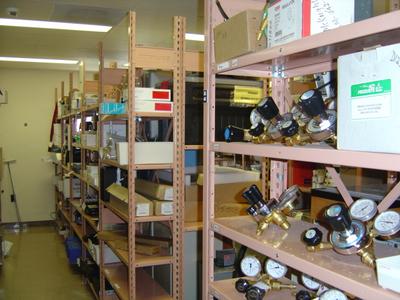
2. The Crary Lab Stock Room
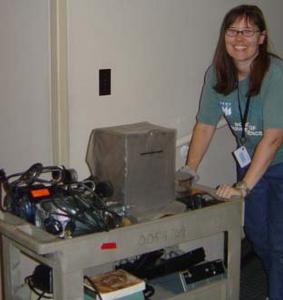
3. Here I am pushing one of the carts containing our gathered lab equipment

4. Items that have not yet been autoclaved.
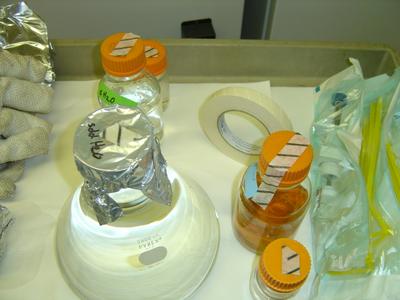
5. These items were not taken off the grill, but rather out of the autoclave. Obviously this is not your normal masking tape. Why would we want to use a tape that changes when it reaches a certain temperature?

6. Our lab a little more organized

7. Liquid media in a shaker bath. Why would we want to shake it before pouring it? Is the media sterile? How do you know?
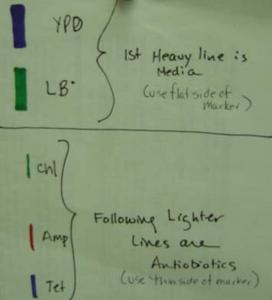
8. Here is the color-coded system that will be used on our plates to indicate the type of media. What do the thick lines mean? And the thin lines? (Hint: Look at the key) We will have two different types of plates. What will our plates look like?
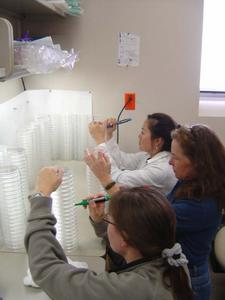
9. Me, Dr. Connell, and Dr. Redman color-coding the plates
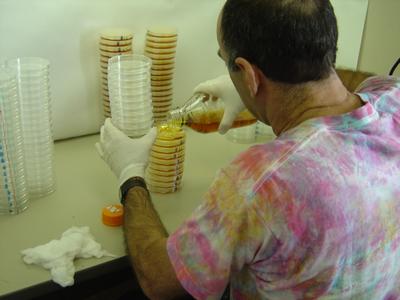
10. Dr. Rusty Rodriguez pouring the liquid media into the plates. The media will sit over night to cool and solidify.

11. Can you tell which plate is which? Why is the agar on the two sets of plates different colors?
Contact the TEA in the field at
.
If you cannot connect through your browser, copy the
TEA's e-mail address in the "To:" line of
your favorite e-mail package.
|
